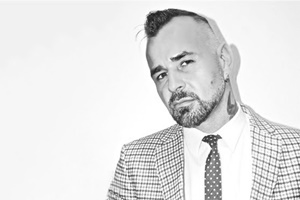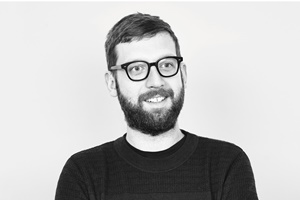
James knowles 2
James Knowles, Online Content Editor, Drapers
Product might be king in retail, but behind the scenes there are fantastic teams working day in, day out to deliver market-leading propositions. So when we launch our annual search for Drapers’ 30 under 30 of rising fashion retail stars, the level of talent that comes oozing out of every corner of the sector never ceases to impress.
This year was no different, so it is with great pleasure we bring you 2016’s Next Generation special, now in its seventh year, in association with Matalan, and sponsored by Arcadia, Topshop/Topman, Coast, Oasis, and Warehouse. Together with our Next Generation event in April, this special is aimed at first, second and third jobbers making their way in the fashion industry across all career paths.
The crowning glory of the initiative is the search for Drapers’ 30 under 30. Such is the anticipation for the list that we receive countless nominations and it is one our most-read pieces of content on drapersonline.com.
This year we have a stellar and varied line-up of the industry’s stars of tomorrow. All aged 30 or under at the time of publishing, they have been selected for their solid career development, key achievements and future potential. To find out who they are, click on the tab above or scroll down to see our image gallery.
You will also find exclusive features including our anchor interview with Thomas Pink chief operating officer Erica Vilkauls, whose many triumphs in a 30-plus-year career include establishing the merchandising function at John Lewis; profiles on five entrepreneurs who reveal the secrets to successfully starting a business; an in-depth analysis of buying, merchandisng, design, and digital career paths; a look at international roles, with interviews with fashion professionals that have already left these shores; and finally, a focus on technical and manufacturing roles.
We hope you enjoy Next Generation and we would love to see you at the event on April 14, where the industry’s leading lights will dispense career advice. Want to attend? All you have to do is Tweet or Instagram a selfie that sums up your “day in the life of fashion” using #DRNEXTGEN. Alternatively, email us three words that sum up the same thing to next.generation@emap.com. Hope to see you there.
TOMORROW'S PEOPLE: 30 UNDER 30
VIDEO: ON THE 30 UNDER 30 SHOOT
DRAPERS INTERVIEW: ERICA VILKAULS

Thomas Pink’s new COO Erica Vilkauls has crunched data for some of the UK’s biggest retail operations to bring the customer into laser-sharp focus
In nearly five years of Drapers Interviews, I have never had an interviewee send me the brief for the shoot before, but Thomas Pink chief operating officer Erica Vilkauls is out to prove a point. Gone are the days when merchandisers were metaphorically chained to their desks number-crunching, she says. Instead, developments in data and analytics have brought them closer to the customer, and demand an even greater understanding of shopping behaviour.
“If we had done this interview when I started, or even a few years ago, we’d have been in an office and I would have had my calculator and PC as props,” says Vilkauls, as we dodge shoppers and the occasional child photo-bomber in central London’s South Molton Street just days before Christmas. “This is what merchandising is. It is customer-centric. It is out here with them, and wherever the customer is, the merchandiser has to follow.”
And for young people starting out in their fashion careers, now is the best time to get into merchandising: “If I look at what the job is now compared with what it was before, it is very different. Merchandising was the support function at the end and now the difference is data. We have CRM [customer relationship management] data, and that is the gold dust. When I was a merchandiser, I had my sales history and I planned on that. I’d known what had sold, but I didn’t know what customers wanted from me.” This means merchandising is more creative and customer-facing than it ever has been, she adds.
Vilkauls would know: her glittering career spans more than 30 years.
“I didn’t go to university – it wasn’t a prerequisite for a good job then. I left school with fairly decent A-levels aged 18 and, whereas lots of people went to university not knowing what they wanted to do, for some reason I was certain I wanted to go into retail,” she explains, as she checks her notes – a merchandiser always does their homework, clearly.
She sought out a management training scheme at a department store, looking at Barkers and Harrods before settling on Dickins & Jones in 1981. The department store was rebranded by owner House of Fraser in 2007. Vilkauls joined the management training scheme at its former flagship on Regent Street as a sales assistant, with the aim of becoming a buyer. Working across many different functions, she attended the College of Distributive Trades in Leicester Square one day a week, where she learned skills such as marketing.
She spent five years at Dickins & Jones, where she says she gained a great understanding of retail and worked her way up to assistant buyer. However, she adds that buyers were very established and seldom moved on, limiting career progression. So, in 1985, she decided to take a step back and become an allocator at the Burton Group.
“I went from having people reporting to me and being a manager to starting again. I didn’t know anything about merchandising, but that is where the openings were,” she laughs. Burton Group, or Arcadia as it is now known, was and is known for its solid training.
“They are probably the best and I still look for people with Arcadia training when I am recruiting,” she says. “It was a competitive environment, but you moved through the ranks if you were good and there were lots of young people – just the place to be when you are in your early 20s and in central London.” Vilkauls was part of the Arcadia team that set up branded sportswear fascia Champion Sports in 1987.
However, she says it was very desk-based and focused on numbers and spreadsheets, seldom speaking about the customer. By 1993, having risen to senior merchandiser, a wave of redundancies left her feeling “the heart had gone”.
Looking for a business that was doing something different, she landed a job at Mothercare as senior merchandiser in 1993, where she says American CEO Ann Iverson was creating an interesting proposition. However, what they did not have was the Burton Group’s systems, so she took on the challenge of working with IT to create standard reports that could be delivered every Monday for trading meetings.
“Before that people were just going through paper, spending 90% of their time gathering data, and 10% using it,” she says. Vilkauls progressed to head of planning – a broader role that helped her learn how to work with different personalities and, crucially, how to deliver information in a way they wanted it.
“One of the key skills in merchandising is getting along with people and having empathy. Sitting back and thinking: ‘Who is this information for?’ taught me an awful lot.”
She left in 1997, and her next big role was House of Fraser’s head of supplier management in 1999.
“What I decided to do at this point and what I would advise people to do is widen their knowledge base. I had been in merchandising the whole time, and I went to House of Fraser so I could look at supplier management, supply chain and logistics,” she says. “At the time the warehouse was at a bit of a standstill. They didn’t understand what was going on in the office, and vice versa. So I introduced forecasting, because it is important the warehouse knows what is coming in and when.”
This understanding of other people’s roles is critical to being a good merchandiser, she says, adding that she always makes her merchandisers spend a day working in the warehouse.
As well as introducing forecasting, she also worked on the launch of House of Fraser’s intranet, to allow suppliers to manage their own accounts.
Vilkauls’ desire to learn new skills led her to leave for lingerie etailer Figleaves.com in 2003 as a buying and merchandising consultant for four months: “I had bricks-and-mortar experience, but this really turned the way I thought about stock and space on its head. It was probably a side-step career-wise but, in terms of my learning and making me a well-rounded manager, it was a massive step forward for me.”
In September John Lewis came knocking. One of the last big retailers to separate the merchandising function from its buying department, Vilkauls could not resist the challenge and became head of merchandising/business lead of change management.
“What an opportunity,” she recalls. “I was never going to get that opportunity again. We really needed to focus on stock management and margins, so we redid the buyer job descriptions and created merchandising roles. I learnt so much about change management and how to go about it differently with different stakeholders.” The process took about two years, during which she also worked on getting the right systems in place, selecting vendor Oracle. However, once change was implemented, Vilkauls did not want to just be head of merchandising.
Hungry for a fresh venture, she joined LK Bennett as buying and merchandising director in 2006: “It was a unique opportunity to come and work for an owner-run business with Linda Bennett, completely different from, and more dynamic than, the corporate environments I had worked for. I have tried to make each career move about learning something new, rather than chasing money or status.
“She taught me a huge amount and it was one of the first businesses I worked for where we spoke about the customer all the time. Linda knew her customer inside out, and taught me: ‘Don’t deviate from what they want because they won’t forgive you and they won’t come back’.” Vilkauls restructured design, product development and buying and merchandising, helped ready the business for international expansion and managed its sale to Robert Bensoussan in 2009.
She stayed on for six months during the transition, but then left and set up Spaldo Consulting – an amalgam of her seven-year-old dog Aldo’s name and his breed, Spinone: “I thought to myself: ‘I have had all of these challenges and I have done all of these things. What do I want to do next?’ I had learned that I liked turning a bad situation in a business into a good one, so decided I could do that for different retailers.”
Clients since then have included Jacques Vert Group and brands A Wear and Animal. Thomas Pink was her latest project, joining as interim chief operating officer in 2014, and taking up the post full-time in August last year.
“It’s a great brand that should be much bigger than it is – so that’s the challenge and why I am here,” she says. Vilkauls started off looking after buying and merchandising and is now also responsible for product development and production, merchandising and buying, IT, logistics and warehousing.
“What’s great about this role is it is wide and varied. A career in merchandising is ideal grounding for a COO role, as it encompasses the entire supply chain.”
Mary Anderson-Ford, managing director of merchandising recruitment specialist AquaRetail, says: “Erica has had a highly impressive career so far, and I think that many of today’s merchandisers can learn a lot from the path she’s taken. As was the case with many of her successful contemporaries, she cut her teeth at the Burton Group – that sort of training early on in someone’s career is absolutely invaluable to learn the rudiments of the role.”
Anderson-Ford adds that her implementation of merchandising at John Lewis “helped them really hit the stratosphere”.
Still, Vilkauls, 54, has more to achieve: “I don’t think I’ll ever retire. I just can’t see me wanting to stop this incredible journey. I hope my next stop is CEO of a great brand that I can expand and make hugely profitable. Then maybe think about the beach.”
CV:
2015 Chief operating officer, Thomas Pink
2014 Interim buying and merchandiser officer, Thomas Pink
2009 Founder and managing consultant, Spaldo Consulting
2006 Buying, merchandising and ecommerce director, LK Bennett
September 2003 Head of merchandising/business lead of change management, John Lewis
May 2003 Buying and merchandising consultant, Figleaves.com
1999 Head of supplier management, House of Fraser
1997 Merchandise and logistics director, The Source Retail
1993 Head of planning and merchandise systems development, Mothercare
1992 Senior merchandiser, Burton Group
1989 Merchandiser, Burton Group
1987 Assistant merchandiser, Burton Group
1986 Senior Allocator, Burton Group
1985 Allocator, Burton Group
1983 Assistant buyer, Dickins & Jones (Regent Street)
1981 Management training scheme, Dickins & Jones (Regent Street)
STARTING OUT ON YOUR OWN
Six successful fashion entrepreneurs tell Drapers how they started and the biggest challenges they faced along the way

Oliver Tezcan
Founder, The Idle Man
Oliver Tezcan learned the buying trade at River Island and Asos.com, where he rose to head of menswear, before branching out with contemporary menswear fashion site The Idle Man. The menswear etailer serves young men’s fashion, stocking brands such as Farah, Vans and Carhartt.
“There’s a gap in the market for men who have outgrown the high street, but don’t want to pay £4,000 for a suit at Mr Porter,” says Tezcan. Price points on The Idle Man average at around £100.
Tezcan is ambitious. His slick 21-month-old content platform offers a personal stylist service and launched its own brand last year, which makes up 10% of sales but is targeted to grow to 20%. International websites, wholesale and even stores are in his sights.
He says funding has been his biggest challenge: “It takes lots of money to build a brand and now institutional investors are looking for tech companies. If we landed five years ago, people would have thrown money at us [because investors were more interested in online retail then].” After a failed fundraising bid on Dragons’ Den last year, Tezcan attracted £1.25m from private-equity investor Foresight Nottingham Fund in October.
Founded:April 2014 Staff: 20 (plus outsourced logistics and customer care)
Profit:In its first year it made a £910,000 loss.
Sales forecast:Net sales this year of £850,000, up 180% year on year in a forecast for the year ended February 2016.

Richard Hurtley
Founder, Rampant Sporting, and managing director, Rich Insight
Studying history and politics at Exeter University was not enough for Richard Hurtley – he also started a fashion brand. His colourful rugby socks were a hit on campus and a website turned his brand, Rampant Sporting, into an internet success.
Despite the brand growing through wholesale, online and events such as Henley Royal Regatta, cashflow became an issue and a £30,000 bridging loan was needed to pay for Christmas orders in 2009.
“It’s costly setting up a brand. There’s not the same financing opportunities in fashion as in tech,” says Hurtley.
However, the loan repayments were crippling and time was nearly up for Rampant until lifestyle retailer Joules saved the day, buying a majority stake in the brand for an undisclosed amount in 2010. Hurtley joined the Joules board and the brand thrived, opening two stores in Exeter and Aldeburgh, Suffolk and selling through Amazon, Asos.com and House of Fraser. Rampant Sporting was sold to licensee Batra Group in 2012 as Joules decided to focus on its international expansion.
Now Hurtley is using the experience he gained at Rampant to help start-ups with his multichannel consultancy Rich Insight. “Success is often seen in pound notes. I value knowledge and experiences. Rampant taught me so much that I can apply elsewhere,” he says.
Rich Insight also helps to pre-package brands to make them more appealing for investors. It recently helped etailer A Suit That Fits raise £1m from crowdfunding.
Hurtley is chairman of UKFT Rise, a network for fashion start-ups. He set up Rich Insight in December 2014 and was named in this year’s Maserati 100, which recognises leaders who support the next generation of entrepreneurs. Rich Insight has three employees.

Clare Serjeant
Founder, Fox + Feather
Location, location, location has been the key to Clare Serjeant’s success with indie Fox + Feather in Bristol.
Serjeant worked in retail since leaving school, gaining experience across many disciplines including buying and property. Sick of travelling in her role at southwest womenswear retailer Mistral, Serjeant was contemplating starting her own business. It was only when she discovered Gloucester Road in Bristol that the plan fell into place.
“It was the perfect location – full of yummy mummies and no other womenswear retailers,” says Serjeant. Despite being seven and a half months pregnant, she went for it, revamping the store on a shoestring budget and buying £15,000 of stock.
“I didn’t want a huge loan – I wanted to be confident and not crippled by a huge debt from day one,” she says. It was make or break: if she did not have a great first week, she would not be able to replenish the stock. The right brand mix was critical and Louche was the must-have label for the area, she says.
Fox + Feather is now a much-loved boutique that has fans beyond Bristol. Serjeant has her eyes on expansion and is looking for a bigger store to accommodate its growing menswear offer.
Founded:2012
Brands stocked: Louche, Girls on Film and Ollie & Nic
Accolades: Best New Business, Drapers Independents Award 2013

Umar Kamani
Founder, PrettyLittleThing
It is no surprise Umar Kamani became an entrepreneur – indeed, it is a rite of passage in his family. His father, Mahmud, is founder of Boohoo.com.
Kamani cut his teeth at Boohoo before setting up a complementary accessories business with his brother, Adam, three years ago. However, it soon expanded into clothing and became a rival to Boohoo. “If you’re going to be in competition, I would rather keep it in the family,” says Kamani.
Kamani describes young “super-fast fashion” brand PrettyLittleThing as “cool, sexy and edgy” and, like Boohoo, it comes with attractive price points: dresses average at £25 and tops at £15. “Girls don’t wear the same dress twice,” he says. “They want a new item every week. We make sure she can afford it.”
The family connections have not made it easy for Kamani: “It’s tough. You’ve got to focus on every detail and be mentally ready for working harder than you’ve ever worked before.”
Unsurprisingly, Kamani is ambitious and wants to take PrettyLittleThing global. Brother Adam has even relocated to the US to scout out opportunities for the brand there.
Founded:2012
Staff: 300 people
Sales:£30m in its current year, according to Kumani’s projection for 2015, up 500% year on year

Julian Dunkerton
Founder and product and brand director, SuperGroup
The young Julian Dunkerton’s ambition was to be a doctor. Three Es at A-Level put paid to that but led the SuperGroup founder to his passion: fashion.
After college, he opened a shop for £30 a week in rent in Herefordshire where he sold clothes he lugged back on the train from London. After a year, he sold his stake in the business for £16,000 and set up Cult Clothing in Cheltenham, which is where Superdry was born in 2003. The brand now has 515 stores worldwide and is as popular in Chicago and China as it is in Cheltenham, where the retailer is still based.
Dunkerton says he was naturally inclined to start a business and shape his own destiny: “I have good survival instincts.” He famously took inspiration for Superdry’s aesthetic from a Japan trip before launching in 2003 after identifying an gap in the market.
“The market was changing, the branded opportunity had shown itself to be the future and being a vertical operation was the only way forward,” he recalls. It was at the Bread and Butter trade show around eight years ago that Dunkerton realised Superdry was going to be a hit. “Half the buyers were wearing our brand,” he laughs.
For those starting out, Dunkerton advises against attempting a range: “Focus on a single product and execute it perfectly.” And beyond that: “It’s about your customer, your team and your business.”
Group revenue: Up 12.9% to £486.6m
Underlying pre-tax profit: Up 2% to £63.2m
Employees: 3,900 (All for year to April 25 2015)
Author Credits:
BEATING THE COMPETITION

The multichannel retail world demands a new range of skills from designers, merchandisers, buyers and ecommerce professionals
Design - Drawing on a spectrum of experience
A successful designer needs to be passionate, driven and thick-skinned, as well as possessing an eye for trend and colour, and a tenacious approach to range building, says Salma Sodawala, managing consultant (design, technical, production and sales) at Henry Fox Recruitment.
Work experience during a design degree is essential, as is continually updating your portfolio with work from your current role and personal projects.
“To stand out you need to translate inspiration, catwalks and street style into wearable pieces,” says Sodawala. “To create a successful range, you must also understand garment design and be ready to get heavily involved in sourcing.”
Coast creative director Neil Hendy looks for a blend of creativity and commerciality when hiring new recruits: “I’m interested in the creative process of how the designer’s mind works. I want to be blown away by the visuals, but I also want people to hit the ground running, so they need the technical skills to understand how a garment goes together.”
Beginning as a design assistant, salaries start at £16,000 and reach £150,000 for a design or creative director. Although the design hierarchy tends to be standardised across fashion retailers, Sodawala is seeing new roles emerging as design departments are being broken down to make the ranges more manageable, and designers moving into specialist roles to focus on areas such as print or knitwear.
To climb the career ladder, you must immerse yourself in the creative world, Hendy advises: “The role is really rewarding, but it’s very competitive at every level. You’ve got to be proactive and look at what other people are doing so you’re armed with as much knowledge as possible.
“You’ve also got to keep yourself creatively stimulated. Explore all the different levels from own label, luxury, high street and value retail to designing for manufacturers. Ask to move departments to gain a broader experience, which shows the aptitude to be promoted.”
Merchandising - Degrees of psychology
Whereas traditionally merchandising was based on maths and analytical skills, today retailers are looking for merchandisers who have an understanding of consumer psychology, believes managing director of merchandising specialist recruitment agency AquaRetail Mary Anderson-Ford: “Those maths/business/finance degrees are no longer set in stone. Now retailers are looking for degrees with modules covering statistical analysis and data manipulation, such as history, geography, sociology and psychology.
“And with the rise of the buying and merchandising courses at the London College of Fashion and Fashion Retail Academy there are a variety of entry points,” she adds.
Abigail Benjamin, head of merchandising at The Outnet, agrees that having a maths degree is not essential for merchandisers today: “There is actually really strong merit in understanding how people think. Success in merchandising comes from the capability to think creatively and strategically about projects, coupled with the willingness to learn.”
The merchandising path usually begins at merchandising administrative assistant level, earning £18,000 to £25,000, climbing to merchandiser on a wage of £50,000 and ultimately to director level salaries of £140,000-plus.
“If you’ve managed your career effectively, you should be earning £50,000 after eight years and £100,000 at around 15 years,” says Anderson-Ford. “I would always advise against a long stint where there hasn’t been any development, but five years in one company where you’ve been promoted or moved to a bigger department is excellent.”
Benjamin agrees that new recruits should learn to pace themselves: “The temptation is to want to do everything, but you need breadth and width. Merchandising is becoming more agile and collaborative. Every day I speak to the technical, buying, marketing and social teams, so communication skills are key. Ultimately, you need to focus on being commercial and delivering for the business.”
A “new wave” of ecommerce, branch and international merchandising roles are emerging, which typically earn 10% less than core merchandisers. So, an assistant branch merchandiser would start on £25,000, rather than £28,000. These non-core roles are catching up, however, says Anderson-Ford, who believes multichannel retailers are starting to recognise their importance for growth.
Buying - Commercial values rule
Buyers are becoming more commercial because of the pressures of multichannel retailing, although product is still king, argues Harveen Gill, managing director of recruitment specialist HGA Group: “It doesn’t matter which channel – if the product isn’t right, it won’t sell.
“So, while being commercial, buyers still need to have that inspiration. As well as knowing how to range build and work out price architecture, it is becoming more important that buyers understand supply chains, sourcing and costing. Also a holistic business approach is key.”
Keeping abreast of world affairs is crucial, as is becoming an expert in the issues that affect fashion retail. Although having a degree is important, to stand out, retailers are looking for buyers who have had internships or shown extra initiative such as blogging.
From his experience as buying manager at Topman and York-based indie Sarah Coggles (now closed), Adam Jagger, retail director of Leeds-based concept store Lambert’s Yard believes an understanding of the customer is crucial: “For an independent I find all the best buyers have come from the shop floor. So, when hiring junior staff, I look for a broad selection of taste and being able to understand the customer. As a buyer at an indie you have to be a jack of all trades. We’re buyers, merchandisers, digital marketing and customer service all rolled into one.”
Wages start at £18,000 for an administrative assistant, rising to £180,000 to £200,000 for a buying director. As seen at River Island and Arcadia, an emerging role is sourcing director or manager, who is responsible for costing suppliers, margins, pricing and ensuring due diligence has been carried out.
“Younger buyers tend to move within a year to 18 months, but the pace of change can stop people becoming grounded,” says Gill. “You need to learn to cope with the setbacks and moving too often can also be seen as a lack of gravitas.”
Jagger advises young buyers to take a realistic view of the role: “You need to realise that there is a lot of admin and it’s not all Paris runway shows. To progress to buying director you need to learn to communicate with every department. It may be easy for the buying team to get your ideas, but if the finance guys don’t then you could be stuck.”
Ecommerce - The next generation
Ecommerce teams must be flexible to adapt to the pace of change, so a willingness to learn is key, says Jonathan Hall, chief executive of ecommerce recruitment consultancy Cranberry Panda: “For online marketing roles, employers like a digital-focused marketing degree, whereas for analytics and insight roles they prefer maths, science or even archaeology degrees.”
In the last two years ecommerce-specific courses have started up, such as Teesside University’s BSc in Digital Strategy Development or Dundee University’s BSc in International Business with Ecommerce, although graduates have yet to arrive in the market.
Having started in merchandising, Karen Millen digital director Charlotte Ellis understands the different “ecommerce generations”: “The first generation typically comes from an alternative background, such as buying or design, whereas the second generation have chosen to specialise in ecommerce at university. We have a blend of both in our team.”
Ecommerce salaries range from £18,000 for an ecommerce assistant to £40,000 for a customer experience manager, rising to £250,000-plus for an ecommerce director. Retailers are increasingly focusing on user experience (UX) and insight roles, with personalisation the real sector to watch.
“Team structures will change next year as a result of the focus on UX, optimisation and personalisation,” says Hall. “Over the next three to five years it will become harder to get natural growth out of ecommerce, so retailers will have to optimise their traffic by creating a seamless customer journey through personalisation.”
Ellis agrees that while the team should focus on the end-to-end omnichannel experience, ecommerce is becoming more focused: “Over the next three years I see roles becoming more specialised. Key areas will be around traffic and acquisition, from generating content to looking at SEO and then ultimately retention and customer communication.”
WORKING OVERSEAS: WISH YOU WERE HERE
Five fashion professionals discuss why they left the UK to pursue opportunities abroad
Fashion is an increasingly globalised industry and Brits are in high demand for roles around the world.
“We’re a nation of shopkeepers and seen as leaders in retail. Many international companies want to hire our talent,” says Harveen Gill, founder of recruiter HGA Group, which has offices in Turkey, South Africa and Dubai. “Lots of emerging markets are experiencing growth in retail and want the talent to facilitate that.”
Different regions demand specific skillsets. The franchise-led Middle East market seeks retail operations expertise, while in areas such as Turkey and Asia, product and creative skills top employers’ wishlists. Australia is dominated by European fashion retailers, so UK design and buying expertise is in demand.
But one of the UK’s most sought-after skills globally is ecommerce. The UK consumer has embraced online shopping unlike any other and it could be argued that the country leads the world in innovation. The UK has already lost many big online hitters to international companies, including former Aurora Fashion omnichannel director Ishan Patel, who was poached by Victoria’s Secret, Amazon UK vice-president Doug Gurr, who moved to become president of its Chinese business and TK Maxx ecommerce director Phil Wade, who joined Australian fashion retailer Target.
Gill reports that emerging markets such as India are looking for British digital talent: “There are emerging markets where shoppers have bypassed desktops for smartphones and have embraced ‘m-commerce’. They need people who have worked in a mature ecommerce market,” says Gill.
The Middle East is another retail hotspot seeking UK employees. Cassie Owen, head of international at fashion recruitment agency CV International, which recruits across Europe, Asia and the US, says demand in the Gulf region is so strong she is opening an office in Dubai this month: “Retail is still rapidly expanding there. Spending and shopping is such a massive pastime over there; it’s always buoyant.”
Franchise giants Alshaya Group and Landmark Group want European talent at a senior level, she adds. Roles such as head of retail, country managers and operation managers are in high demand, as are buyers, merchandisers and ecommerce professionals.
With its tax-free, high-flying lifestyle, Dubai is a popular destination. Nevertheless, Owen urges would-be globetrotters to do their homework: “You’ve got to look into cost of living. Dubai, for example, is very expensive and rents are at an all-time high. Also, working hours can differ. The Middle East has longer retail hours and 50-hour weeks can be the norm.” Owen advises new recruits to go through their contract with a fine-tooth comb before signing, particularly the relocation package.
Drapers contacted five British fashion émigrés to find out what the opportunities are abroad and their experiences of life as an expat.

Camille Clifton, senior graphic designer and co-ordinator at womenswear retailer Forever New, left the UK for Melbourne, Australia, in 2008
Why did you move to Australia? The outdoor lifestyle and weather. I used to live in Leicester and travelled every day down the M1 in the rain to Asda’s George. Now I spend weekends at the beach.
How did you find the job? My sister worked in New Zealand, and she recommended I try job site Seek.com. I had a stroke of luck that the [Forever New] chief executive Dipendra Goenka was visiting London and could interview me.
How is working life? The hours are not as long as the UK, where working until 8pm or 9pm was the norm. There is not that culture here – there’s a better work-life balance. The salary is higher than the UK, too, but the cost of living in Melbourne is quite high.

Camille Clifton hasn’t looked back since going down under in 2008 to work for Forever New in Melbourne, Australia.
How has your career progressed in Australia? I started at Forever New as a graphic designer. Now I manage the four-strong graphics team. Forever New has a great energy. I’ve been here seven years – the longest I’ve ever stayed at a job.
Is your role in demand in Australia? Yes and being English makes you quite attractive. Australia is inspired by European fashion trends and English design schools have a good reputation.
What’s the best thing about working in Australia? The lifestyle. Melbourne is great and you can visit some beautiful places just down the Great Ocean Road, from lovely beaches to vineyards.
Will you ever return to Blighty? I don’t think so. I’m settled here. I have an 18-month-old and another baby on the way.
Young womenswear brand Forever New has 290 stores in 10 countries. Other big Australian fashion retail employers include Jeanswest, Myer and David Jones.

Ford Hamilton, design and product development manager, joined clothing producer Must Garment Corp, part of Must Group, Hong Kong, in 2008
Why did you move to Hong Kong? I was looking for a new opportunity and a shift in position. I love learning new things in the fashion industry and thought it could broaden my knowledge and future opportunities.
How did you find your new role? Drapersjobs.com
How is the working culture in a Hong Kong fashion firm? Expectations are higher here. They give you more responsibility much quicker and expect you to be able to learn things very fast. It’s not like in North America, where there is a real on-boarding process; you really need to watch and learn quickly. You have to be prepared to work hard to play hard. If you’re the kind of person that likes routine and regular hours, it is not the place for you.
Is your job in high demand in Hong Kong? Hong Kong is small and lots of people want to live here, so competition is high. Salary expectations are much higher in Hong Kong and the cost of living is higher than London.

Hong Kong might be expensive, but with higher salaries and great weather, Ford Hamilton is staying put.
What are the working hours and holidays? The hours are 9.30am to 6.30pm. However, there are busy periods when we can work very late. Generally I’m there until 7ish. You get fewer holidays than the UK – around two to three weeks a year. However, you do have far more public holidays – 18 days a year to be specific – so it evens out.
What’s your favourite thing about living in Hong Kong? I like the weather. Hong Kong Island is 65% National Park – there are beautiful beaches, great hikes and several other little islands close by that you can visit for the day or weekend. You can hop on a plane and go to Thailand, Vietnam, Cambodia or Malaysia for a long weekend.
Must Group employs 10,000 people globally and supplies US and UK brands such as Gap, Primark and Ralph Lauren. Other key Hong Kong fashion employers are Lane Crawford and Li & Fung.

Kat Erasin, visual merchandising manager at luxury multi-brand retailer Boutique 1 Group, Dubai, United Arab Emirates, left the UK in 2014
Why did you move to Dubai? I’d been working in London for a while [including stints at Harvey Nichols and French Connection] and thought it was time for a change. I’m young, free and single, so why not?
How was the recruitment process? I applied for the role with CV International. I did two Skype calls and then a final telephone interview with the chief executive Ziad Matta. Boutique 1 paid for my travel and accommodation while I found my feet. They also sorted out the visa and medical examinations.
What are your working hours? My role is not 9 to 5. Retail here is intense: store staff work six days a week and there are no part-timers.
Is your role in high demand? Yes. It’s difficult to find locals with good creative skills. All the management team here is Western. It took more than six months to recruit for my role.
Is working in Dubai as glamorous as some might think? It can be a bit superficial. I take trips to Oman or Abu Dhabi for the weekend to make sure I keep myself grounded.

Creative skills are in high demand in Dubai, with local fashion businesses finding it hard to fill roles.
Has your career progressed since moving? I’ve developed in so many ways. I work across every aspect of the business and get a view on everything. In London, I was just pigeon-holed as a visual merchandiser. I also report into the chief executive. I would never get an opportunity like that at my level in the UK.
And the salary? It’s higher than the UK. In fact, I think I’ll find it hard to come home as I’d have to take a pay cut. But the cost of living here is very high.
Do you have to be sensitive of any cultural differences? It’s more conservative here but I’ve never had to change the way I dress. It’s not as strict as people think. I wish had known that when I came; I bought an entire new [conservative] wardrobe.
Boutique 1 has two stores in Dubai and one in Beirut. Alshaya Group,Landmark Group and Chalboub Group are also employers in Dubai.

David Clark, head of buying, men, at etailer Zalando, Berlin, moved to Germany last year
Why did you make the move to Zalando? I’ve always wanted to work in Berlin and was hearing great things about Zalando. I’d worked in London for 11 years [latterly at Asos.com] and was after a change of pace.
How does working for Zalando compare with a UK firm? It’s much less hierarchical and competitive. The way of working is more fluid and feels far less top-down. Things are changing, morphing and developing here on a daily basis. It’s a very exciting place to be.
What are the working hours like? It’s pretty similar to the UK – 9am to 6pm – but we have flexible working, so you can start at any time between 8.30am and 10am.

With its wealth of culture and an international working environment at Zalando, life in Berlin has lots to offer, says David Clark.
Is the language an issue? Zalando is a very international company with more than 100 nationalities working here. Our first language is English and [those who are not English speakers] are offered lessons. I’m actually taking German lessons, though. I know embarrassingly little so far!
How have you found Berlin? It’s a much slower pace than London. It’s a city built for 8 million people but houses only 3.5 million. The streets are much quieter than in London and you get to work much more quickly. I’m a bit of a foodie, and there are so many great restaurants and bars here.
Zalando operates in 15 European countries. Among Germany’s other big fashion employers are Adidas, Puma, Otto Group and Hugo Boss.

Alice Thomas, planning assistant, joined etailer Ezibuy, Auckland, New Zealand, in 2014
Why did you move? I’d visited Australia and New Zealand before university, and always wanted to come back. I did the backpacker thing back then. This time I wanted something different, and decided to actually settle here and get a job.
How did you find your new role? I registered with a retail recruitment agency – it seems to be the way things are done here.
How was the interview process? Relatively straightforward. The agency contacted me and I had my first interview the same week. It was pretty standard and I found out a few days later that I had got the job.
How did you find the on-boarding process? Everyone was friendly and welcoming. They provided great training on the systems and processes. I’ve made good friends here and I love working with them.

A friendly working environment, understanding bosses, and a beautiful country. Alice Thomas can’t fault New Zealand.
How is working in New Zealand different? Companies are a lot more trusting and accommodating. When things come up outside work, they’re understanding. That builds a strong relationship and it makes me want to give more as an employee.
Is your job in high demand in New Zealand? There are fewer retailers here, so there is never going to be the same level of demand as is in London. However, having experience from the UK retail industry [Thomas worked for River Island] is an advantage. The salary is higher here than in the UK.
What are the hours and holidays? Standard hours are 8.30am to 5pm, and 20 days’ holiday a year.
What’s your favourite thing about living in NZ? It’s a beautiful country and I have a stress-free job that allows me to enjoy it.
Ezibuy is the largest omnichannel fashion and homewares retailer in Australasia. New Zealand’s other big fashion employers include Kmart and Farmers Trading Company.
WEAVING YOUR WAY UP

Reduced but still alive and kicking, UK manufacturing can offer a range of interesting career paths
In 2014, the UK fashion industry made a direct contribution of £26bn to the economy – up from £21bn in 2009 – supporting 797,000 jobs, global forecasting consultancy Oxford Economics reports.
When most people consider a career in the fashion industry, they tend to think of “front of house” roles, such as design, buying or retail. Less is known about the technical roles, such as pattern graders, cutters, technicians and machinists, that manufacturers, retailers and brands need to fill. Although there has been a significant decline in UK manufacturing over the past 40 years, there is a reduced, but still sizeable, industry operating, and these skills are very much in demand, not least because they are now so hard to find.
It is hard to ascertain the exact proportion of people employed in these roles from the 800,000 or so working in the fashion sector (as estimated by Oxford Economics), but there are notable examples of this demand. The north London factory of not-for-profit social enterprise Fashion Enter started with eight workers in 2008, and now employs 84 people, supplying retailers such as Asos.com and Marks & Spencer. Meanwhile, in November 2015, Burberry announced plans to invest £50m in a new factory in Leeds, expecting to create employment for more than 1,000 people. So for those seeking technical and manufacturing careers in the sector, there is cautious optimism.
“There is some drift of companies looking at the UK and I really believe this will continue, especially with costs rising in places like China,” says Ian Scott, non-executive chairman at organic clothes brand Frugi and former head of technology and procurement at Marks & Spencer. “It is certainly happening at the higher end of the sector and hopefully this will continue.”
In addition to rising costs in the East, other factors are influencing this shift.
Matthew Vohs, founder of fashion retail recruiter Vohs & Co, says the ability to get products delivered in four weeks, instead of six to eight weeks, is a key consideration, while British provenance also has strong consumer appeal: “If you look at woven goods, where fabric has been converted from UK fabric mills into garments, you get a lot of ‘Made in England’ now,” he says.
These small but encouraging signs of growth means strong demand for a range of skills, from quality controllers to machinists, pattern cutters, graders and technologists. Scott says openings are appearing, particularly in designer clothing. Cornwall-based Frugi, for example, has an online retail business, 400 stockists across Europe and turnover of £6m. It employs around 60 staff.
“Their manufacturing may be overseas, but the design, buying and technical development is done in Cornwall,” says Scott. “They are always looking for new talent in the technical area – at the moment they are looking for senior garment technologists.”
It is a role Salma Sodawala, managing consultant at fashion and retail employment agency Henry Fox Recruitment, says is hard to fill: “A lot of people think they can do the job of garment technologist, but they are often not used to working at the pace required.”
Karen Millen production director Fay Tear concurs, explaining that the role of a CMT (cut, make, trim) garment technologist involves working closely with the pattern cutter and advising the factory on issues such as stitch tension.
“But, most importantly, our garment technologists are the communications tool between our designers in the UK and our suppliers, who are predominantly in the Far East,” she says. “They ensure that the fit and the quality are consistent with Karen Millen’s standards.”
Tear adds that garment technologists at Karen Millen need around 10 years’ experience in the role: “They will also have had college experience and then gone into industry, and they will have worked for another premium brand.”

Contrary to reports, technical skills are needed at retailers, brands and manufacturers across the UK
Pattern cutting is another skill much in demand, but it is a role that can vary according to the way each factory works, as Sodawala explains: “Some will work manually and some will work on Gerber [a US software package] systems or Lectra [a French software package] systems, while some will work flat, literally creating [a pattern] on the table.”
Iwona Lenartowicz is a senior digital pattern cutter with women’s designer label Roland Mouret. She previously worked as a freelance pattern cutter, learning how to use the Gerber system, and believes opportunities for pattern cutters in the UK are plentiful and varied: “With branded and designer labels you get to be more creative, using both draping methods on the mannequin to digitising and then developing on the computers and toiling,” she says.
Bernice Miller founded pattern-cutting and design service Creative Fashion Services in February 2015 and expects her team of three to double in the next year. Her customers are independent brands and designers such as Caroline Beyll, Lueji and GR LondonParis.
She says pattern cutting is a skill that takes years to develop: “Basic knowledge is important and can be attained from studying a pattern-cutting course at college or university.”
Experience is also key: “We find it very difficult to help people who haven’t had at least a year’s placement,” says Sodawala. “If the option is there to get a placement year, take it. The experience is invaluable.”
Lenartowicz agrees: “Try to work with different types of companies to find the right level for you, and work on multi-products to find your niche.” She adds that learning the Gerber system is “the future”.
Tear says pattern graders – who ensure that each style fits across all sizes and is consistent – are also highly sought after: “It is a very technical and complicated role. They take all the pattern pieces within one garment and grade it. Every size has to look perfectly proportioned, including any styling details.”
As with other technical roles, experience is key, but so are interpersonal skills: “Some people have the technical skills for these roles but they don’t have the people or professional skills,” says Tear. “You are working in a business environment, in teams, and you have to be able to build relationships – sometimes that can be quite a challenging combination.”
There are also more niche roles available. Johnstons of Elgin manufactures cashmere, woollens and knitwear at its mills in Hawick and Elgin, Scotland, for its own brand and customers such as Jaeger and The White Company. It employs just under 1,000 people, of whom 200 have joined in the last two years. One of its key roles is a technical dyer, responsible for ensuring that materials are dyed to the required shade. The company has two trainee technical dyers, as three members of the team are approaching retirement.
“It is vital that we have the right people fully trained to take over these roles,” says chief executive Simon Cotton, adding that candidates need excellent colour vision, qualifications in both chemistry and physics, and an aptitude for mathematics. “[Our trainees] are studying for a qualification from the Society of Dyers and Colourists, and at the end of four or five years they will have a degree-equivalent qualification. After three to four years’ training, they should be able to run a shift by themselves.”
Johnstons of Elgin is proof that the fashion industry is not solely based in London and Manchester – opportunities are widespread.
“In Leicester you have the Next buying team, but there are also a large number of manufacturers in the Leicester and Nottingham area that supply fast fashion retailers,” says Frugi’s Scott. He also highlights Northampton’s shoe industry, where Church’s and Barker are based, and the southwest, home to clothing label Seasalt and surf brands such as Finisterre, as well as Frugi. “The opportunities are out there,” he says.
Sodawala agrees, adding Derby to the list as a big knitwear producer: “Factories are starting to open up in these areas again.”
And persistence is key to climbing the ladder, says Tear: “Get your foot through that door, talk to everyone you can and have a great ‘can do’ attitude. That is your way in.”
PARTNER COMMENT
In association with: Matalan

Emma Crossland, head of HR, Matalan
Our focus at Matalan on nurturing young talent to achieve their potential mirrors the objectives of Next Generation. We are committed to developing people from work experience and internships through to graduates and beyond and this process highlights the great talent we have as a result.
Matalan had a huge year in 2015. We moved to our brand-new purpose-built head office in Liverpool and opened our first store on London’s Oxford Street, signifying investment in the future of our business and our people. Our second Christmas campaign with Alder Hey Children’s Hospital brought together an array of celebrities and thousands of people to raise awareness and money for the hospital through sales of our beanie and bobble hats. To top the year off, our founder, John Hargreaves, was awarded the Drapers Lifetime Achievement Award. All this in our 30th anniversary year.
This year is going to be even bigger and our people will be at the heart of everything that we do. We’re launching a new development programme, “Me (Matalan Education)”, across all our trading, support and retail teams. This will bring to life the career opportunities we have within our business, and it’s important the next generation are equipped to deal with the pace of change and the demands of working within fashion. Our 30 under 30 nominations this year are perfect examples: showing how it’s possible to build successful, exciting and rewarding careers within retail.
We can’t wait for the Next Generation event on April 14 and to celebrate the amazing young talent we have in the UK fashion industry.
For career opportunities at Matalan click here.
Sponsored by:

For career opportunities at Arcadia click here.


Andrew Skinner, managing director, Coast
The secret to growing our business and continuing to delight our customers with a unique, beautiful and highly commercial product offer is by continuing to grow and develop our most valuable resource – our Coast team. As a small brand we’re committed to developing and building our talent from within; recruiting people at the start of their retail careers and then investing in their training and giving them real responsibility and accountability early on to learn their profession in the most hands-on, effective way. All of that explains why Next Generation is a great match-up for us at Coast and why we’re thrilled to not only be a partner throughout 2016, but hopefully for many years to come.
For career opportunities at Coast click here.

Amelia Lietke, people director for Oasis and Warehouse
Oasis promotes a culture of open learning to encourage talent to develop and grow. There is equal emphasis on formal learning and social learning combined with practical experiences within the brand. The ethos of 30 under 30 for Oasis is to recognise individual achievement within the industry and use the programme as an opportunity to regularly review the growth and impact of talent within the business. Oasis uses an in-house development team to give advice on learning and educational opportunities that will ensure continuous growth.
For career opportunities at Oasis click here.

Warehouse is dedicated to growing future talent which is why Drapers 30 under 30 is important for the brand to be a part of. In house development experts work closely with the Brand stakeholders to maintain a diverse development offer for recognised talent. Within retail Warehouse has a highly successful ‘Tales of Talent’ initiative that successfully develops talented individuals for their next role. Warehouse has recently been involved with a new initiative from the Retail Trust where under 24’s are given an opportunity to experience working for the brand. This will be supported in the future along with apprenticeships to ensure a talent pipeline.
For career opportunities at Warehouse click here.

